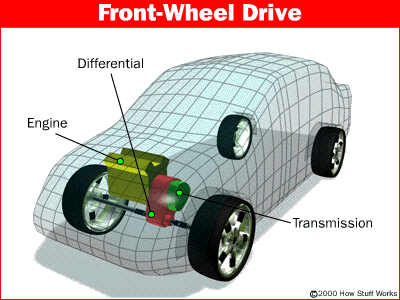The Planetary Gear set
From left to right:
the ring gear, planet carrier, and two sun gears
When
you take apart and look inside an automatic transmission, you find a huge
assortment of parts in a fairly small space. Among other things, you see:
·
An ingenious planetary gear set
·
A set of bands to lock parts of a gear
set
·
A set of three wet-plate clutches to
lock other parts of the gear set
·
An incredibly odd hydraulic system
that controls the clutches and bands
·
A large gear pump to move
transmission fluid around
The
center of attention is the planetary gear set. About the size of a
cantaloupe, this one part creates all of the different gear ratios that the
transmission can produce. Everything else in the transmission is there to help
the planetary gear set do its thing. An automatic transmission contains two
complete planetary gear sets folded together into one component. See How gear ratio works for
an introduction to planetary gear sets.
Any
planetary gear set has three main components:
·
The sun gear
·
The planet gears and
the planet gears' carrier
·
The ring gear
Each
of these three components can be the input, the output or can be held
stationary. Choosing which piece plays which role determines the gear ratio for
the gear set.
Planetary Gear set Ratios
One of the planetary gear sets from our transmission has a ring
gear with 72 teeth and a sun gear with 30 teeth. We can get lots of different
gear ratios out of this gear set.
|
Input
|
Output
|
Stationary
|
Calculation
|
Gear
Ratio
|
|
A
|
Sun
(S)
|
Planet
Carrier (C)
|
Ring
(R)
|
1
+ R/S
|
3.4:1
|
|
B
|
Planet
Carrier (C)
|
Ring
(R)
|
Sun
(S)
|
1
/ (1 + S/R)
|
0.71:1
|
|
C
|
Sun
(S)
|
Ring
(R)
|
Planet
Carrier (C)
|
-R/S
|
-2.4:1
|
Also, locking any two of the three components together will lock up the whole
device at a 1:1 gear reduction. Notice that the first gear ratio listed above
is a reduction -- the output speed is slower than the input
speed. The second is an overdrive -- the output speed is
faster than the input speed. The last is a reduction again, but the output
direction is reversed. There are several other ratios that can be gotten out of
this planetary gear set, but these are the ones that are relevant to our
automatic transmission. You can try these out in the animation below:
Animation of the
different gear ratios related to automatic transmissions.
So this one set of gears can produce all of these different gear
ratios without having to engage or disengage any other gears. With two of these
gear sets in a row, we can get the four forward gears and one reverse gear our
transmission needs.

















.gif)








